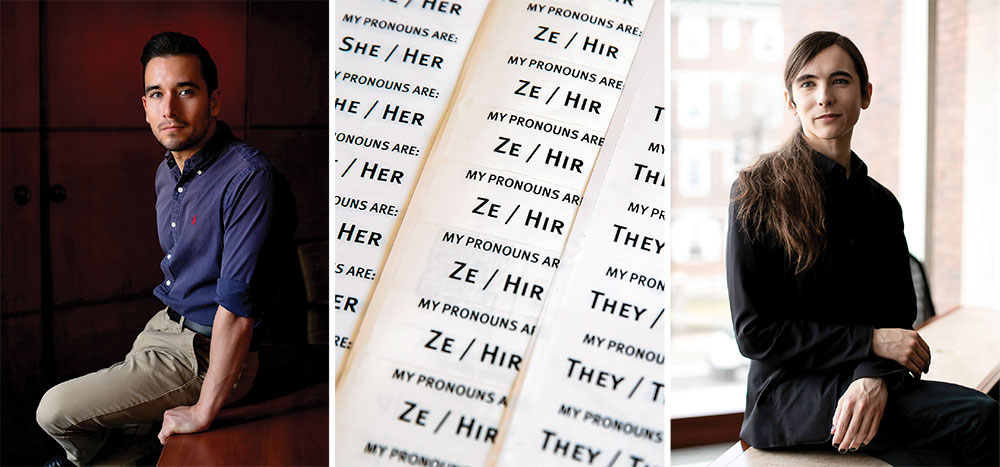Planning November 2020
How-To
Tips for Gender-Inclusive Planning
Language, like planning, has the power to transform communities.
By Hally Turner, AICP (she/her), Tim Burkhardt, AICP (he/him), and Jake Reilly (he/him)
The words we use about identities can be rooted in harmful attitudes, stereotypes, and unconscious bias. These biases are the judgments we innately make that inform our understanding, actions, and decisions. In short, the words we use matter.
That's why equitable planning starts with inclusive language. By embracing gender-inclusive language, planners, officials, and the public agencies they represent are actively demonstrating their commitment to dismantling their biases, engaging everyone in the planning process, and building an equitable experience for all.
Gender and language 101
Gender and sex are often used interchangeably, but they have different meanings. According to the World Health Organization, gender refers to socially constructed characteristics like "norms, behaviours, and roles associated with being a woman, man, girl, or boy." Gender exists on a spectrum that includes "woman" and "man" but is not limited to that binary categorization. Sex, on the other hand, is a label assigned at birth based on observed physical attributes. Importantly, a person's gender can be different than their sex assigned at birth, WHO says.

Diego Garcia Blum (left), a Harvard graduate student, created these stickers with pronouns like the nonbinary "ze/hir" to help prevent the misgendering of fellow students and faculty. "I think it's valuable, generally speaking, to challenge the norm that you can assume a person's gender based on appearances," Raven Graf (right), a nonbinary student whose pronouns are "they/them," told the New York Times. Photos by Kayana Szymczak/The New York Times.
Putting it in practice
Using gender-inclusive language means communicating in ways that do not make gender assumptions and do not perpetuate gender stereotypes. For instance, it is becoming standard practice to avoid using one gender to refer to many people (e.g., "he" as universal), masculine job titles (e.g., chairman, fireman), or assuming "she" when referencing nurses or teachers. Similarly, using gendered pronouns, like "he," excludes many people along the gender spectrum. Instead, gender inclusivity includes actions like deferring to gender neutral language and using "they/them" pronouns when referring to people whose gender is unknown.
With a little learning and a lot of practice, planners can make all members of their communities feel more welcome. Here are nine helpful guidelines to follow:
1. BE ACCEPTING
Acknowledge that people have the right to define who they are regardless of your perception.
2. SEEK OUT STORIES
Learn about people's unique lived experiences by seeking out different stories in the things you watch, read, and listen to. Learning is the key to building broader understanding of gender inclusivity. You will make mistakes, but committing to learning will help you avoid more mistakes over time.
3. CORRECT YOUR MISTAKES
When a pronoun is misused, correct yourself and move on — apologies should be avoided. Apologizing could result in the person being harmed to focus on comforting the person apologizing. Self-correction, on the other hand, shows a commitment to changing behavior.
4. BE NEUTRAL
Be mindful of the ways your language upholds gender stereotypes and reinforces gender as a binary construct. When interacting with the public or coworkers, replace "hello, sir" with "good morning." Instead of kicking off a public meeting with "ladies and gentlemen," try phrases like "colleagues," "guests," "friends," or "patrons." In a group setting, identify people by articles of clothing instead of using gendered language. For example, the "person in the blue shirt," instead of the "woman in the front."
5. SHARE YOUR PRONOUNS
Normalize this practice by giving your pronouns when you introduce yourself, add them to your email signature, and write them on name tags. By sharing your pronouns first, you create space for others to share theirs as well — and it's a great way to disrupt the normalization and privilege of assumption.
6. USE "THEY"
While its usage as a singular pronoun may be new to many of us, "they" is a rational choice when describing an individual as well as a group — and most style guides back up its singular usage. Normalize this practice by using "they" to refer to an "anonymous" individual, as well as people who use the neutral pronoun.
7. DO RESEARCH
Research how to make your community more gender inclusive. Understand how recent court rulings impact gender inclusivity. Use resources like the Human Rights Campaign's Municipal Equality Index to know how inclusive laws, policies, and services are of the people who live and work in your community.
8. ADVOCATE FOR GENDER-FRIENDLY POLICIES
Family leave policies, dress codes, and a lack of all-gender bathrooms can serve to isolate people of different genders. It's important for women, nonbinary people, and others to be able to live, dress, and have their gender respected at work, at school, and in public spaces. Planners have influence over the creation and use of public spaces and can influence policies to make all people feel welcomed.
9. RESPECT PRIVACY
People may or may not want to share their gender identity publicly.
These guidelines can be used to create safe, welcoming spaces for everyone without putting the focus on any one individual's identity.
Hally Turner is policy planning director with Minnesota Department of Transportation. Tim Burkhardt is director of transportation planning with Alliant Engineering. Jake Reilly is a sector representative and senior planner with the Metropolitan Council.


